Today’s short selection of reviews covers the period from June 1st to about June 20th. Having suckled at the Disney teat for longer than I desired, I was banished from those lands mid-month, and having paused (but not fully cancelled) my Netflix subscription, I received a surprise notice that I had been re-subscribed. All very tiresome. A ery short list this time of one TV show, two films, a book of ‘history’(?) and a big chonker of an Art book I have had for ages but finally dove into.
Skelton Crew, by Disney
Green Knights, Black Angels. The Mosaic of History by Peter Vansittart
Predator, Killer of Killers
Velvet Buzzsaw, by Dan Gilroy
De Lempicka, Art. by BoSz
Skeleton Crew
From the creators behind much of Marvels Spiderman films; a bunch of kids from a very sheltered world discover a crashed Pirate vessel and end up 'lost in space' with a mad droid and questionable Jude Law. Light 'Goonies'-influenced adventure and peril ensue.
PIRATE PUPPETS
Most fun thing about the show is the new puppet vibe. All of the funky shit that was largely banished from 'Andor' ended up here. Disney has found new synthesis of physical puppetry and digital 'gilding' that integrates the two near seamlessly, meaning we get all the benefits of Puppetry with actually properly moving mouths and faces, well mainly properly, but I genuinely can't tell from scene to scene where high level animatronics end and digital begins.
The three best (and main) puppets are;
SM-33 - Pirate Droid, voiced by Nick Frost.
I think this guy is 99% puppetry with a dab of digital gilding. He *feels* like a heaving mass of chaotic metal and potential danger.
Neel - 'Myykian Youngling' with voice by Robert Timothy Smith, performance artist Kacie Borrowman, an animatronic head AND facial motion capture.
Neel and his blue elephant family are also the CUTEST LITTLE FUCKERS imaginable.
Brutus - a Shistavanen Male played by Fred Tatasciore (voice) and Stephen Oyoung (performance).
I assume the method of creation was like that of 'Neel', but it could have been a pure animatronic head, who knows? There is also a full CGI character they run into in one episode. The puppets really add to the playful and energetic vibe of the story and of the galaxy being shown.
DROID TROUBLE
During his extensive 'victory lap' for Andor, Tony Gilroy talks a lot about the initial pitch for the series he was asked to review; it was 'Andor and K2S0 go on missions'. His criticism was that K2S0 is a fucking nightmare for storywriting. He’s huge, hard to disguise, very strong and powerful. So a lot of 'Rogue One' was made up of finding ways to keep him offstage. If you have him in the show half of the show is going to be Andor telling K2S0 'go wait in the ship'. (Famously, Justice League writers have the same problem with Superman, who is constantly ‘on a mission to Jupiter’, while ‘Avengers’ writers have the same thing with Thor.
This problem shows up a fair amount in 'Skeleton Crew'. One of the two, (and the less malignant) of the 'Long John Silver' characters is the storytelling droid and intro-to-piracy character SM-33, and a staggering amount of story energy is spent making SM-33 either more or conditionally, less powerful, having him 'stay with the ship' or alternately leave the ship for reasons, warping or restoring his memory and so on. In a purely plot sense, the whole show is about the droid, and about the manipulation of the droid which, if it was working at 100% and actually wanted to, could have speed-run the story itself.
LONG JOHN SILVERS
Long John Silver of 'Treasure Island' is simply a great damn character. Charismatic, very likeable, something of a father figure to a fatherless child. Also ruthless, dangerous, self-interested and full of plots, plans and schemes. A defender and educator of the protagonist, but also a moral, and eventually, physical, threat. Having him interact with 'Jim' (I think it was), is always a hive of dramatic energy as the cross-potentialities of the relationship hum.
'Skeleton Crew' has two Long John Silvers. One is the droid SM33 who gives the children access to the realm of Piracy, but who also has a dodgy memory, is bound to the obscure and fluctuating 'Pirate Code', can be alternately super-dangerous in combat but also utterly useless, can repair and pirate the ship, but won't do so without orders, and who might also murder the children if they break any one of a range of obscure instructions. The other is Jude Laws multiply-named fake Jedi imprisoned Pirate Captain, who somewhat guards, manipulates, threatens, occasionally feeds, serves, and dominates the children.
Maybe to some extent the double 'LJS' lessened the energy of the story and reduced the complexity and interest of the characters. In another sense it was quite interesting and novel. In particular the fluctuating and shifting memory of the very-powerful SM-88 puts the droid in an usually-complex story-position.
Jude Law does a decent line in formerly-abandoned-child who clearly has some Jedi powers but also doesn't know too much about them. I thought in the end his character was over-explained. Anyone who knows the setting will assume he is a survivor of Order 66 who was abandoned to the galaxy very young, half-trained and turned into a baddie. A lot of the interest of his character is drawn from this inferred back-story, it makes him more interesting to be around. But in the end, in what feels like a note straight from Lucasarts, the script is very careful to tell us that this is not quite what happened. It feels slightly off.
LIKEABLE
A somewhat sweet not too irritating show. I have no idea if shows made for children are actually good. At times it seems dedicated to instilling certain messages which seem to me to spring from the churning psyche of the American liberal bourgeoise but there is not too much of that.
Its certainly a little janky in its plotting and it seems to me that it probably began life as a film script? It has the slight sense of distortion and mild busywork that the opening shows of the corpo streaming revolution had. Like those shows, if you took all of the really good scenes from this and put them in a film you would have a pretty good film. Though if Disney was actually making a film the chances of the good scenes being the ones that got in is low.
Green Knights, Black Angels.
The Mosaic of History by Peter Vansittart
Mosaic is right-worded; this book is like a painting, or a series of them. Like Thomas Coles 'Fate of Empires' , the chapters being more like images than chains of signs, or strange still pools into which we gaze, full of curious and multitudinous life, impenetrable depth and, wavering over all, our own distorted reflection.
Because it has no 'story' except that forced on it by the procession of events, because it has no single, grand idea beyond the book itself; like a window, or time spent meditating in a garden, each small age has its stories, and those have morals, lessons, handy fragments hung up here and there, here a good king, there a bad, but the book is not about those, it simply includes them, they are its substance not its end. We drift and hover through history, like swallows swooping through an open barn door, hopping here and there, wherever Vansittart’s eye or memory lands, very like sitting in a garden, sitting in its centre, letting your eye pass clockwise from plant to plant, scene to scene, but with the ambient life of the whole there in every moment and each part, or like sitting in the same garden for a year, watching it ebb and grow, wither and change, but ever the same.
"England is an old house packed with memories."
And this is very much 'of England', and from my perspective, of Southern England, though it has the whole world in it, (Confucius turns up), it is the world seen from the Shire, as Hobbits might discuss it.
"Discoveries are inexhaustible. It is like looking at a rock, an abstract painting, bark or an old ceiling. The surface eventually breaks down into figures and suggestions, dreams and designs. Or as a cricketer sees endless traps, risks, opportunities in an apparently blank strip of grass. It is like the piece of wood which Rimbaud describes as suddenly finding itself to be a violin."
It is a book of details, a mosaic of quotes, memories, references. In the first chapter alone, 10 short pages, we have 'Brian Branston's 'Lost Gods of England', Hilaire Bellocs 'Epigrams', a traditional song of the Duke of Monmouth, a selection from William McGongalls 'Beautiful Railway Bridge', (famously one of the worst poems in the English language), and a fragment of John Masefield. Its roughly one quote a page and keeps up roughly this density for the whole of the book.
Vanistart can write. He can go in high mode and medium (not low). On the few occasions this sensitive, deeply-read and deeply cynical man allows himself to get excited he works mild wonders;
"Presiding was Henry VIII's magnificent daughter, fierce in argument, unstable, energetic, diplomatic, wracked with pains, terrified of death and old age, treating life like one of her own courtiers; mean, shifty, splendid and indomitable, tempered perhaps by sudden despair and terror, berating the Commons or a tactless ambassador, swearing like a pot-boy or orating like Churchill, hunting at all hours, teasing, scolding, goading, playing on virginals, brooding at a window, hesitating, deceiving, respectful to God but not servile .. her prayers must have been skilful diplomacy between two equals .. vain but not fantastic, capable of kindness yet with her tragic and bloody memories probably cold at heart ... she seems to sum up the talents and enormities of her family. It is doubtful whether she could never have been loved: it is more doubtful still whether she could have been despised. we remember her long Italian hands and red wig, her sharp oaths, 'God's Death, my lords ...' her crises of fury or pretended fury, her planned withdrawals, her headlong grief for Essex, her tenderness to the dying Burghley, her venom, expert showmanship, her courage and vigour... dancing at 65 before the entire court, hand in hand with young Essex.. standing for hours, days ,at the very end, in a final effort to out-stare death... 'I saw one night my body thin and fearful in a light of fire'... grimly chuckling at the unending failures of King Phillip and his Catholic God, eager for quick talk and fine tales, owning shares in a slave-ship, The Jesus, haggling over stores and supplies like a peasant, centre of flattery, pageants, fawning courtiers and intrigues, and always profoundly, richly, alone. Toward the end, she who had out-faced axe and dagger, Spaniard, Scot and Pope, and who had banished all mirrors, now, after many years, dared look into one, an image of dread and finality. Crooked as her carcass, Essex had said."
If Vansittart was making an argument, we would have to say it was badly supported, but he is just saying things, taking us on a journey, or perhaps making poetry of time.
For sure there are arguments inside the book, many and several. Proclamations, declarations, certainty in passing, and if you happen to be read on a subject Vansittart skips past, you may well find room to disagree Its not just wandering; he does analyse and describe;
"The real problems were not caused by careering villains and swashbuckling heroes. The arrival of American silver, the economic policies of Henry VIII and particularly the rise in population created economic crises that few seventieth-century bankers and politicians were equipped to tackle. From More and Wolsey to Cromwell and Fairfax prices continually mounted. Bankers, lawyers and traders prospered but at the expense of traditional landowners and labourers. The Crown, itself and landowner, was expected to do more work in defence, communications, law, patronage and national prestige but with less money, because of inflation."
But then, within a handful of words;
"Lady, Queen Anne she sits in the sun,
As fair as a lily, as white as a swan."
We should not forget the actual images, nor the building of the book. Its very lovely, a sideways text (ages 12 and up, but what in gods name would a twelve year old make of this?), with the letter blocks kept in spine-aligned squares, strips of negative space set with powerful, sometimes repeated, black-ink illustrations by Rosalind Dease, each, like the quotes and fragments, taken from some historical source. The 'Black Angel' of the title page is Ethiopian, but there are many more, others come from Psalters, drinking cups, cathedrals, Saxon hordes, tarot cards. Was Vansittart just carrying these around in some sort of scrap book somewhere? Probably, he seems the type.
What comes of all this is a kind of common-place book, or a mosaic of time, a parade of grand images - of surreal collages, each encapsulating the spirit of an age, or of a mood of time, a thread of England’s causality, very beautiful as art, compelling, engaging, fascinating, like rooting through an old mans strange cupboards while he is out.
I said the book didn't have a Big Idea behind it, but he explicitly says there is! I will let Vansittart have the last word;
"I wrote this book hoping to make the past part of our present. Not merely to show-off or pretend absolute truth, but to interest some reader into seeking further for himself - over the hills and far away -among trolls and computers."
Five stars, but only as an example of its genre, of which it may be the only one. One of those 'first-found' fossils which are transported to a hidden room and kept, maintained as exemplars of a type.
Predator, Killer of Killers
ANOTHER surprisingly good, mildly woke Predator movie? Oh its by the same guy as 'Prey', ok.
This is much more comic-booky and actiony, and tbh is based on a meme; what if a Viking and a Ninja teamed up to fight Predators wait! Its actually good! Possibly the third best Predator movie; Predator > Prey > Killer of Killers. Though maybe second best if you like animation.
Animation style is post-Spiderverse, and has the mild frame clipping, slightly abstracted movement, models with complex texture, and other elements used to create that particular look.
Just as in the Spiderverse films and the best of 3D animation generally, (Tai Lungs prison escape in the first Kung-Fu Panda movie I will never forget you! kisses in chat!), the medium translates very well in the tightly choreographed, stylistic three dimensional action; things move, throw, fall, spin, strike and clamber with pleasing textuality and a nice sense of space and time.
The voice actor for Ursa, the bitter Viking woman-warrior is really very good.
She spends much of her time cursing in what I assume is ancient Scandinavian. Just from her voice I was assuming a woman in deep middle age, a weathered and angry as the character, maybe someone who fought Stellen Skarskard on the street at some point, but the VA is called Lindsay LaVanchy and is the most baseline normal American you could possibly imagine. So.. top acting there Miss LaVanchy.
The story is made of four twenty minute short stories, three where each of the main characters encounters a Predator in different time periods, then a fourth where they all meet up. A book of short stories really, and this works very much to the favour of each tale as, very deeply compressed, they can only fit the actually good stuff in, and can only focus on ONE main character thing, and this does not run dry because each story is short. More; something in this seems to have unleashed the genre-wilfulness in the directors as these stories are much more freely high genre than perhaps others would have done, I mean one is literally about a Viking on a revenge quest, one has a Ninja and opposed brothers and one is PREDATOR VS WWII..... IN THE SKY. Just the most fun ideas you could have, executed with immediacy and rapidity. The loss of the English language from much of the story also helps - since the dialogue isn't expected to be understood by much of the audience, all of the storytelling works without it, taking the weight off and letting the speech-craft breathe.
In its pro-feminism and mysteriously non-racist past, 'Killer of Killers' hangs just within the boundaries of possibility, though not representation of statistical reality. In the same way the Comanche in 'Prey' definitely didn't do a lot of quite sketchy things the actual Comanche did and were a 'softened' version.
Do I care about this? Do I actively want to see more women being beaten up because their upper body strength and mass isn't high enough? more anti-Latino racism and the Comanche punching out the teeth of the women they own? Probably I don’t? Am I woke now? Perhaps.
The softening of this Trachenberg-Predator paracosm is no worse with its minority groups than pretty much all 'white' or 'euro' pop history is with its glorious Yamnaya-descendants. A representative truth would probably be unwatchable for a normal audience. I hardly think this is a meaningful moral crime. However, it should be noted. It plays a small part in a much larger cultural trend of filing off and remaking the past into something much, much less racist, male-dominated and baseline harsh than anything the past actually was.
Velvet Buzzsaw
Jake Gyllenhaal has tremendous fun playing a very EXTRA bisexual art critic in this solid-C not-that-frightening film about haunted paintings.
A surprisingly carefully researched and constructed concatenation of the Art World, interrupted by mixed genre elements.
Zawe Ashton's oppressed paint stooge finds her upstairs neighbour dead; Outsider Artist discovered! The dead man wanted his extremely SPOOKY AND MYSTERIOUS paintings burnt, and was trying to burn them himself, but Zawe robs the bunch and, after being gazumped by her more intelligent and ruthless boss, Rene Russo, they cook up a scheme to cheese it on the corpse-draws.
Magic intervenes; the painter, Dease, was a vector for horrible trauma his entire life; abused and almost certainly an (occasionally somewhat justified), murderer. The paintings, painted in..... BLOOD!!! are evil, magic and can warp reality - they start to take revenge!!(!)
The care, observation and systematic construction of its world, and the solid economics and plotting, all remind me of other Gilroy-clan works. They are secretly a gang of normie worldbuilders I think. Clearly they are doing research, building a complex working reality, and then putting the story inside it, rather than just winging it.
The social observation, life-worlds implied by fragments of dialogue, power tussles, manipulation and interesting intrigue are all good. This could be a series where we just walk around with art-folk. They do look lovely.
Gyllenhaal is a better special effect than anything else in the film, if you don't mind him going very high. Rene Russo is, in a role not unlike her 'Nightcrawler' part, a tiger in human skin, encountering something even more dangerous. She's great. Employ this woman! Zawe Ashton is the glue and does a good, rapid, turn to utter-bitch throughout the story. Malkovich and Toni Collette are customarily good. Tom Sturridge has a nice capsule role as sleaze.
Its not scary and while the dooms are somewhat imaginative, they don't, within themselves, add the dark poetry you can sometimes get with Reality Horror. One film that unnerved the shit out of me was Oculus - its tricksy mirror felt truly demonic, like a patient predator more intelligent and imaginative than its prey. House of Leaves has scale and depth. In 'Buzzsaw' even when the art-dooms have potential, they seem to pull back or to fear getting really truly strange; Tom Sturridge enters a gallery exhibition three-sided house, turns around and finds the fourth wall has been added, turns around again and finds the painted walls have become real and he is now fundamentally Somewhere Else...
then a ghost goes WOOO and strangles him.
Neither do they really cohere into the loose pseudo-sense I prefer in horror. The Oculus Mirror can make you see and sense things that aren't there, but it can't stab or hang you, it has to get you to do that yourself. The House of Leaves can spookily summon you in with its call-of-the-void but you are, at least initially, allowed to nope-out, its as much a spiritual as material threat.
In Buzzsaw, some deaths have Final Destination Rube Goldberg aspects, others; reality-altering paintings, another just brings a robot to life and chimps out on a guy. Toni Collette’s death-by-modernist-sphere is less unnerving than the fact that when the gallery staff find her body, they assume its an edgy art exhibit and people turn up to mutter and look. I feel like in every case things could have gone further and been deeper.
The film is not that great but it does have solid bones. Fragments of the characters have regurgitated in me. Most are 'bad', but almost all of them were originally driven by something more than greed, Russo's Rhodora Haze is a former punk who found her lover/friend OD’d in the bathroom and made a lifetime heel turn into Alpha Gallery Bitch, Gyllenhaal’s Morf Vandewalt does actually care about what he does and while ridiculous, is un-bribable, at least until desire draws him into art-sin; he gives a bad review for a show he thinks is good and the artist dies by suicide/accident the THAT VERY NIGHT... Many of the other characters have their own great or minor failures, little personal arcs. The 'Velvet Buzzsaw' of the title is the punk band Rhodora Haze abandoned in her youth; its near faded tattoo on her neck ensures her doom, even after she has ritually cast away all other art to escape the art-ghost of Deese.
All these people abandoned themselves, in small ways or large, before the spook. And the ghost parts are not actually that good. The film might be better if you took the visible supernatural out of it, and just had the bodies discovered and characters die in a series of strange and unlikely "incidents". These things do happen after all, and sometimes they happen in strings. Everyone in the cast has something to feel guilty about and without an actual ghost, their cope and hyper-reactions would speak more to the much-stronger non-genre side of the film. Maybe one day I will do an edit!
But there is genre in the film and the nature of the art-spook is also interesting. In the words of 'TV Tropes' of all things;
"There is also the motive of the art itself."
Deese was horribly abused. His mother and sister die in a 'mysterious fire'. He is arrested for killing (horribly) his abusive father. Once out of the asylum he hides from the world. His bully boss at his workplace is found dead in a field with his hands tied. That’s about it for the evil of Dease. Two bodies confirmed. The art analyst thinks the blood in the paintings was all his, and he was trying to burn the paintings when he died.
So what are the paintings and what do they want?
Their main targets seem to be anyone trying to profit off Dease's work, and specifically anyone betraying his stated desire that the art be burned. In this reading they enact the will of their creator and spontaneously destroy themselves like a Mission Impossible tape. Neat, simple and somewhat-fair.
Or do the paintings want to be spread? Are they hunting, infecting? A demonic darkness formerly contained within one man, now loose. Even relatively innocent people do seem to be darkly influenced by the sheer presence of the works. In this reading Dease was an almost heroic incubator for darkness, holding it back within himself, and the Paintings killed him when he started to burn them.
Its a curious thought on the nature of trauma, evil and violent harm; which vision these living echoes adhere to. Was Dease healing himself, harming himself - an incubator for darkness? Bravely holding back a violence someone else placed there? 'This ends with me'. Or a Stephen King vector or carrier for something Other right from the start. Would he have been simply better off not painting at all? Different murky visions of moral darkness are all slightly implied, each procedural aspect of the supernatural infers a different morality and reflects a different sense of the art-as-metaphor for human action. Maybe this really could be a TV series! Each painting encapsulating a different morality of darkness, and interacting, both procedurally and metaphorically with a different living situation.
De Lempicka, Art. by BoSz
Welcome to the Cubist City of Extremely passionate but Languid Vampires.
Tamara de Lempicka; born to wealthy Russian Jews on the borders of the 20th Century. Fled Russia for central Europe (Paris and Italy) after the Revolution. Husband in prison, fresh baby girl, jewels all sold. Solution - simply become the most famous portraitist of the age!
This she does by talking her way into nobles castle (house if you want to be prosaic), impressing him with the two paintings she actually has, he offers her an exhibition in a few months, for twenty paintings. She doesn't have them, but says she does, spends the next few months painting 24/7 and manages to complete them all by the required date. Exhibition is a triumph. Fairy-tale protagonist confirmed. (Though I suppose in a true fairytale something would have gone horribly wrong after making the False Promise.)
Tamara then asks for the price of the most expensive portraitist in town, adds some on and makes that her price, then sells portraits to the poshest most European people imaginable.
(Its during this period that she has a very memorable few days in the house of Italian writer Gabriele D’Annunzio, which are later leaked in s scandalous tract by the poets lover/housekeeper/procuress Franco Maria Ricci, which then forms the basis for John Krizanc's groundbreaking play 'Tamara', which, if you want to read him being irritating about, here is a link; https://journals.kozminski.edu.pl/system/files/265-944-1-PB.pdf
THE 'ART DECO' PAINTINGS
Its these pictures, painted between about 1924 to 1935, later called the 'Art Deco' paintings, which capture the spirit of the age, make her fortune and her reputation.
Cubist Bodies
I came to Tamara through my interest through the female Vorticist-aligned woodcut artists of the mid 20th century, especially Agnes Miller Parker, who I found through her Woodcuts for 'The Fairy Queen'.
Like a lot of cubist paintings these people look like piles of dropped artisanal Legos, but really cool and fancy beautiful Legos, dropped in the most exquisite ways.
Vorticists, and Cubists I suppose, are good, very good with space and objects and can barely perceive the human soul. Women do tend actually care about human beings.
So if you get a female Vorticist, like Agnes Miler-Parker or a female cubist portraitist, like Tamara, you get this complex approach to form and space AND you get humanity at the same time.
How can something be simultaneously jagged and round? The bodies are made out of shapes, the arrangement of the shapes is jagged, impulsive, crossing, aggressive, nearly chaotic, but the bodies are also soft, rounded, sometimes vulnerable, tactile. This grand paradox is more visible in Tamara's many paintings of babes and hot women of which it seems she could never make enough.
Certainly here was a woman who loved women.
City of the Vampires
The poshest people imaginable have arrived to feel languid and intense.
They are not really doing anything; they are embodying wealth, yes, but not crappy American democratic wealth, instead; extremely fine and limpid European style mid-century wealth. The last gasp perhaps of Jaques Barzun, or Sephan Zwiegs Old Europe.
Everyone Tamara paints feels like they might be a vampire or the victim of one. Intensity! And possibly sexy secrets or tragedies. Eyes fixed on the horizon or staring into the soul; no-one is contemplating anything ordinary, or thinking about anything normal. These are very noble (in the blood, not moral sense) people, having noble (blood again), thoughts.
Another curiosity is the cubist buildings which appear behind many of the portrait sitters, some of these are drawn from New York, after Tamara visited there, but others I think are extemporaneous, pure invention. Being who I am I can't help but think of these as an actual environment, something like Burtons Gotham or Goyers Dark City, a shifting modernist pre-war darkscape populated exclusively by magnificoes.
Babes
It’s a vitally important part of Tamaras process that she regularly make paintings of slightly thick, beautiful naked women in complex body arrangements. Sometimes you are going to need a few naked women for a picture.
Look, I don't make the rules here. In an addition to the vampire rule, most people, especially in the 'Art Deco' era, are sexy, or a damn sight more sexy than they probably were irl, the babes fall away in 1935, but return, a little, flowing into new streams of beautiful women, softer now, in Mexico and the southern USA
Sheen and Cool
A friend said these looked like images from the 1980's, and they do, but probably the truth is that images from the 1980's look like Tamara de Lempicka art from the 1920s.
The sheened surface, cool to the touch but still expressing life and sex. Take it too extremes, or do it less-well, and you have bad 80s art, or plastic toys. Remove it entirely and you have 1970s granola. Horrid. But here, it is less like a sheath, or armour, and more like silk moving over living skin, (which to be fair is often exactly what is on show), a world of tender shining surfaces. It reminds me of a day long ago when I received a new prescription from the optician. Without realising, I had been walking around in a very blurred world. With new contact lenses added, I discovered before me a world of staggering depth and distance, complexity and exactness, a very lively world, but one whose liveliness was communicated through objects. Very different to the old world, of which I had seen less, but with which I had interpenetrated more, it being a wash of textures and blurs.
BOOK AND LIFE
The book, which is I think as complete a record of her works as you can get, has the quality common to such things, in that it casts a lamp upon her life, all of it, and the core works which everyone knows about, and which presumably most people are buying the book for, are like a slender wedge, taking up only a particular slice of time.
Beksynski's book from the same publisher; BoSz, is also a bit like this, lots of photographs and drawings, then a ten or twenty year stretch where he is pumping out the genre-influenced dream images everyone recognises, then a very long period of very white and very blue paintings, which no-one talks about (they are pretty good).
Geiger, (so far as I can see), is unlike this. He feels utterly Geiger, and a massive ham, right from the point of setting up a cool and edgy dark-jazz club in his parents basement, all the way right to the end. His art does change, but it all communicates a certain essential 'Geigerness' that changes in its expression but feels like it has strong inner continuity.
The War
Reading the histories of 20th century artists and writers, WWII is like a famous character that turns up in everyone’s story, fundamentally re-writing it.
For older types, like Herbert Read and Tolkien, WWI provides the key interruption and they are left to respond to WW2 from a distance as older men. In a way Tamara gets both; the Russian Revolution casts her from her home, removing any certain future and setting her upon her own resources. From this she clambers free, into the, for her, decadent and glorious time and life of inter-war Europe, then BOOM, war comes to get her again.
She escapes one more time as, again, the war eats her future and her carefully built modernist reality, she is banished to America, where she survives, even thrives, defiant, but increasingly out of place in the evolved cultural backwash of the modernism she helped to create. Until the 1970s when her 'Art Deco' portraits, so long out of fashion, are re-discovered, and form part of a particular re-creation of the idea of Glamour in a now more-democratic, and presumably uglier, but still bodacious age - images of the most high-bred euro-physiognomy Counts and Barons now adorning the walls of singers and producers.
For a woman who had her life destroyed twice, her defiant upturned chin and ferocity in living, her relentless work to protect her only child, and her continued interest in thick babes, makes her feel heroic - in a position of domineering power these same attitudes might be agonising, unpleasant, but held to against the twin black hurricanes of the 20th century, and the cultural aftershock of the post-60s, they lend Tamara the tincture of Knighthood, a dusky, perfumed high nobility of character.
Tamara NEVER SMILES in photographs, even from early youth her vibe is set to 11 from day one, an invincible shield of armour, endlessly renewed from the heart, head always tilted slightly up, eyes hooded, gaze direct
However, others, especially family members, _do_ smile around her, which is the opposite of a danger signal if you think about it, and Tamara does smile in two photographs with her daughter, Kizette, she smiles like a goon.
Survivor, and Vibe Queen, Till Death.






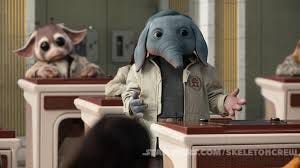

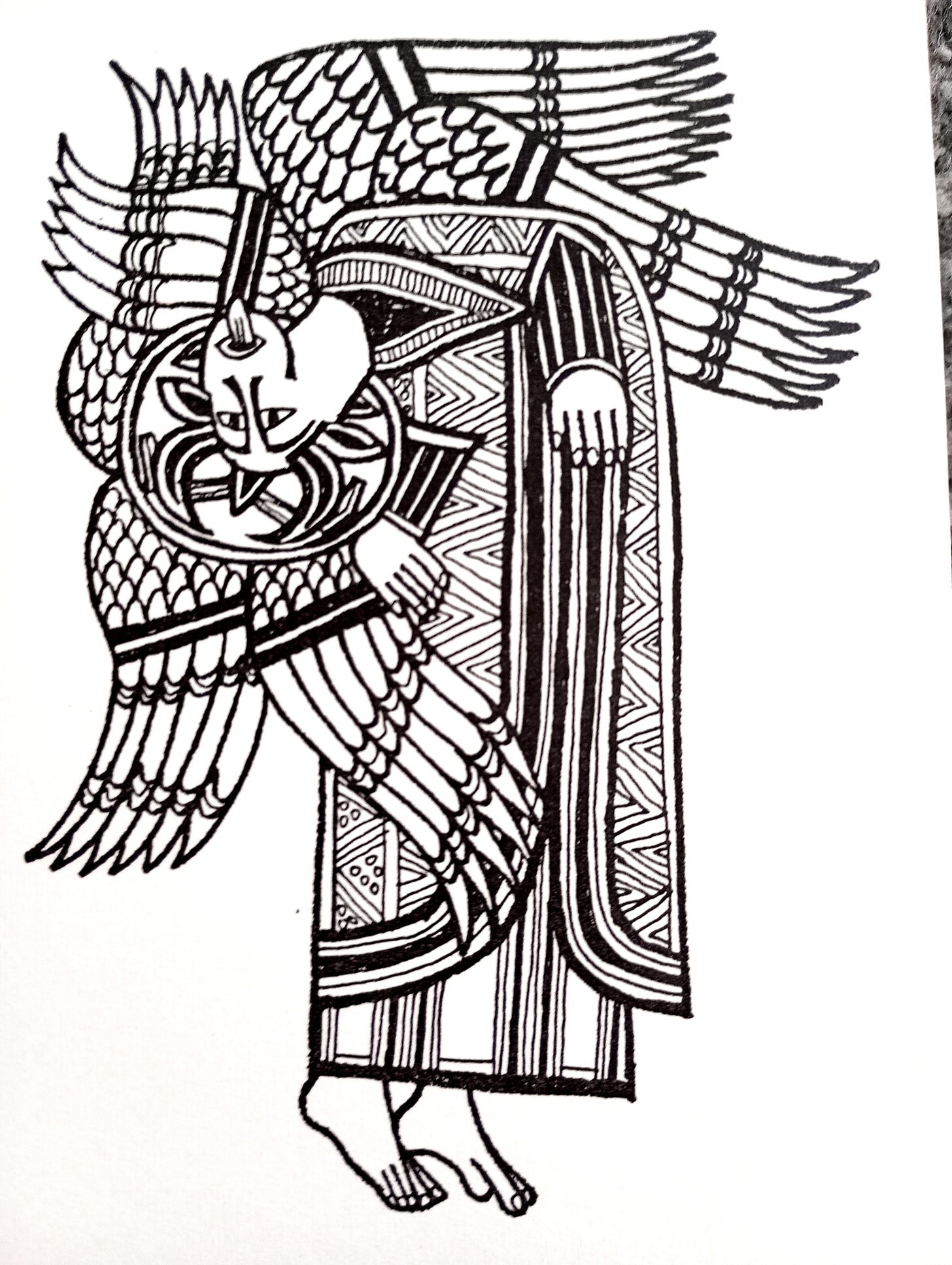
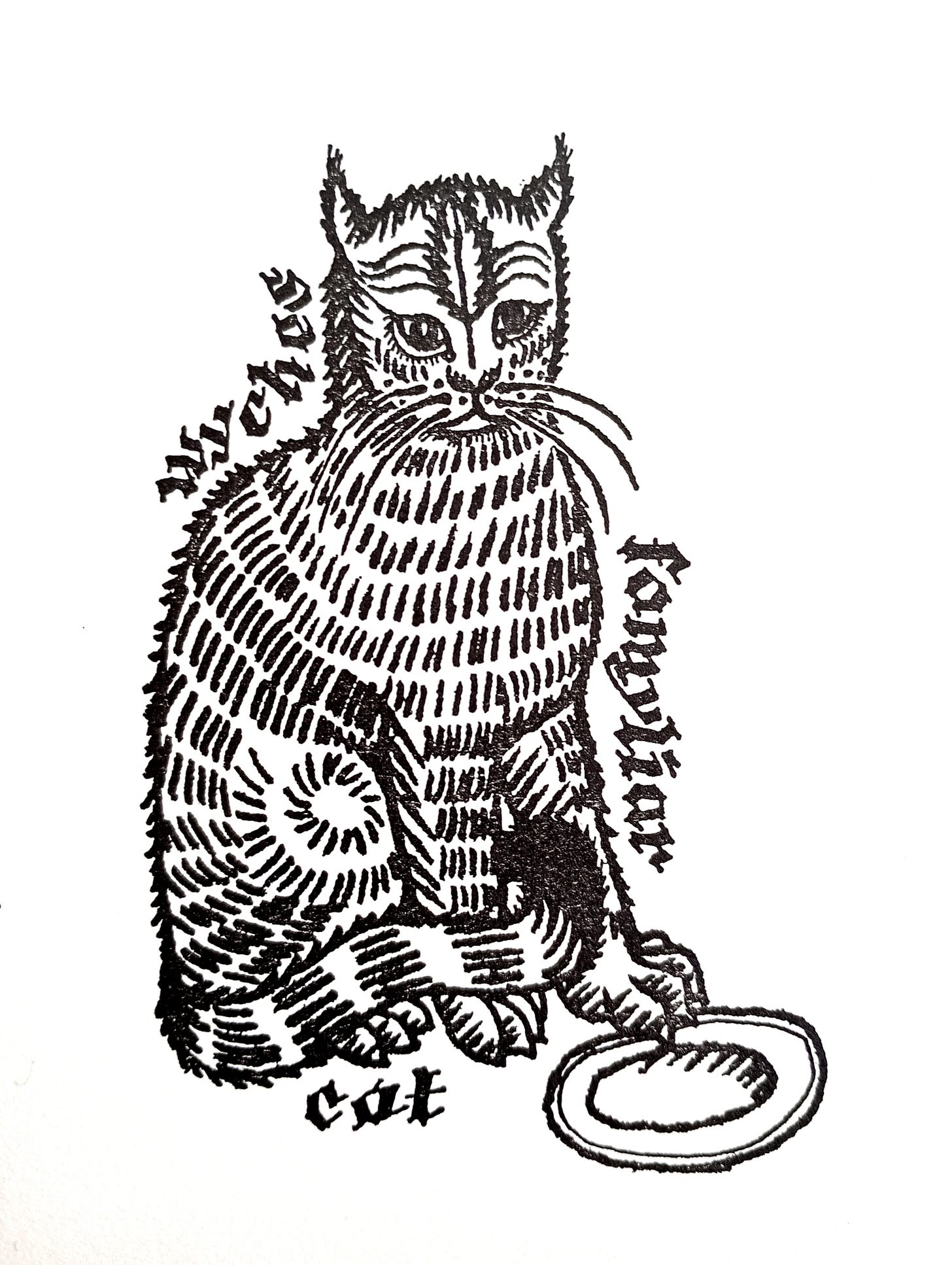

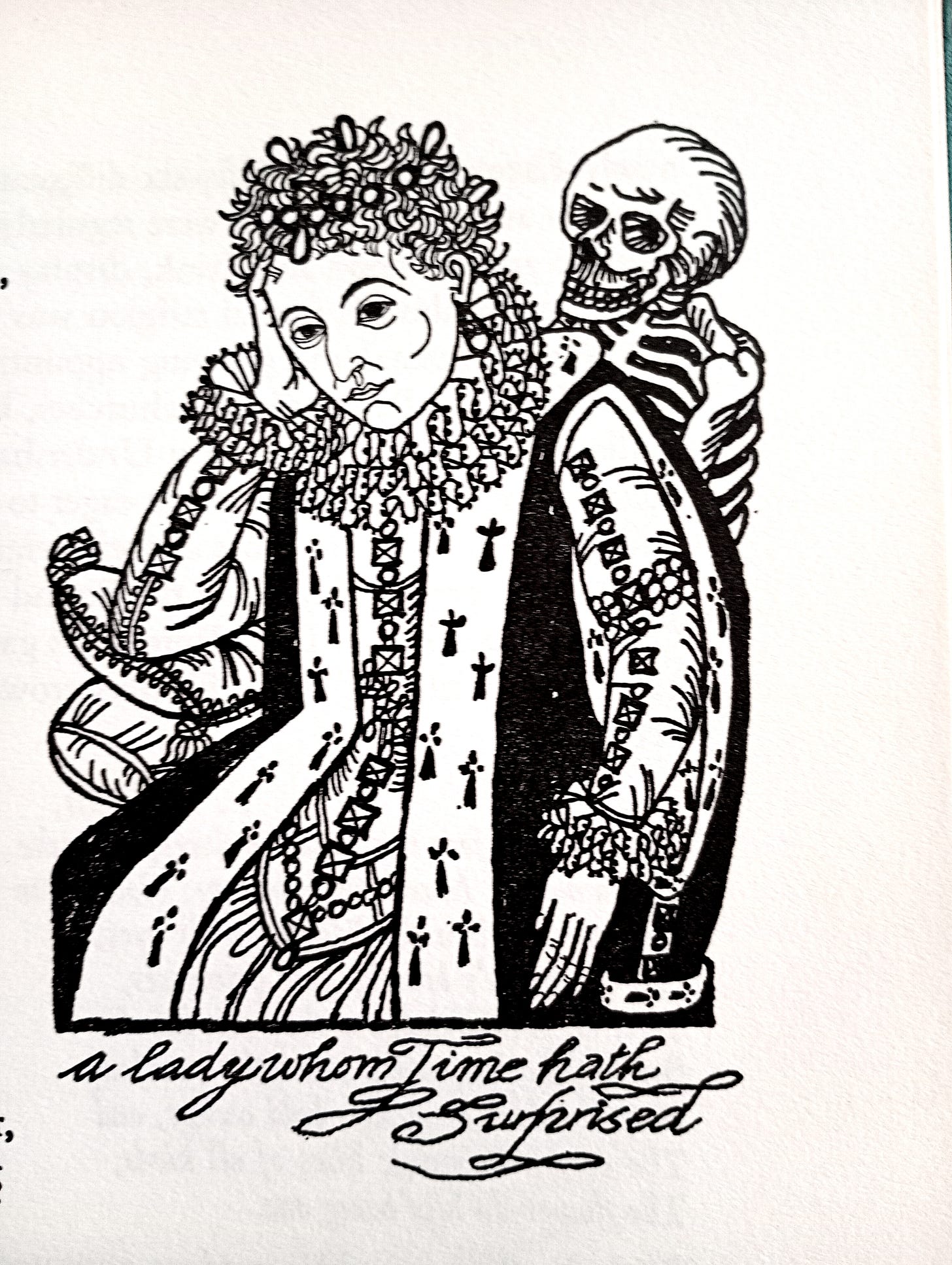
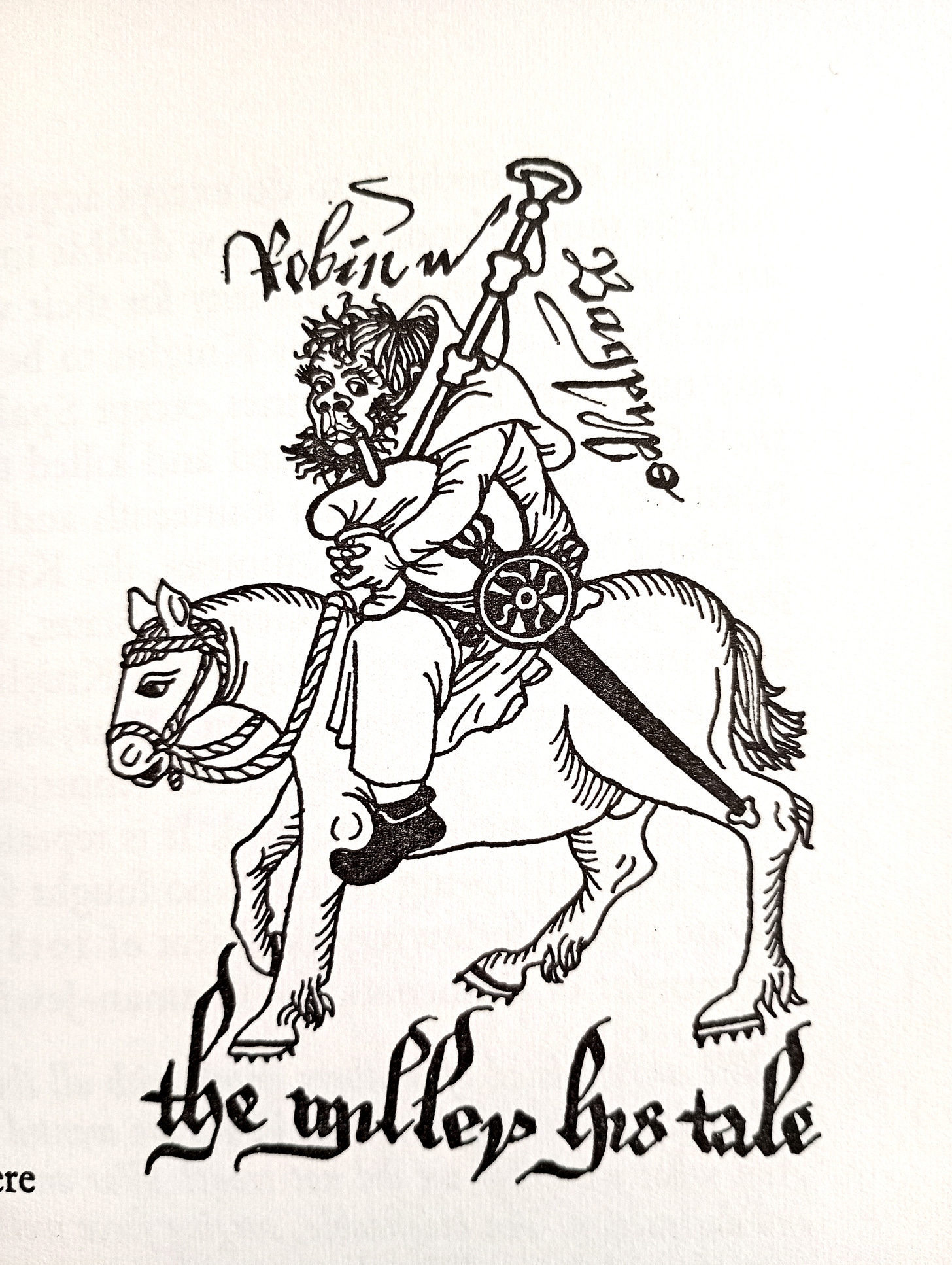

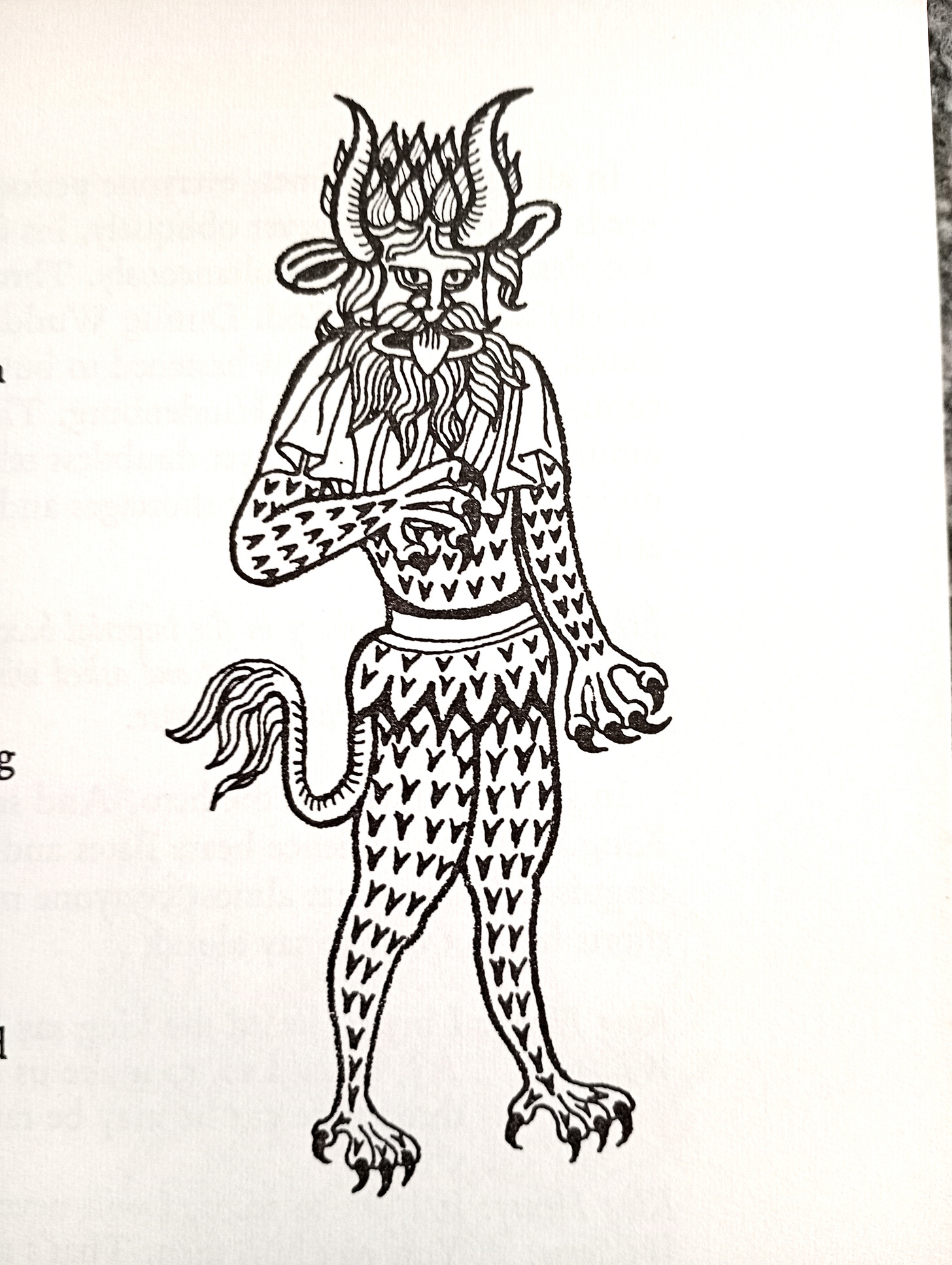
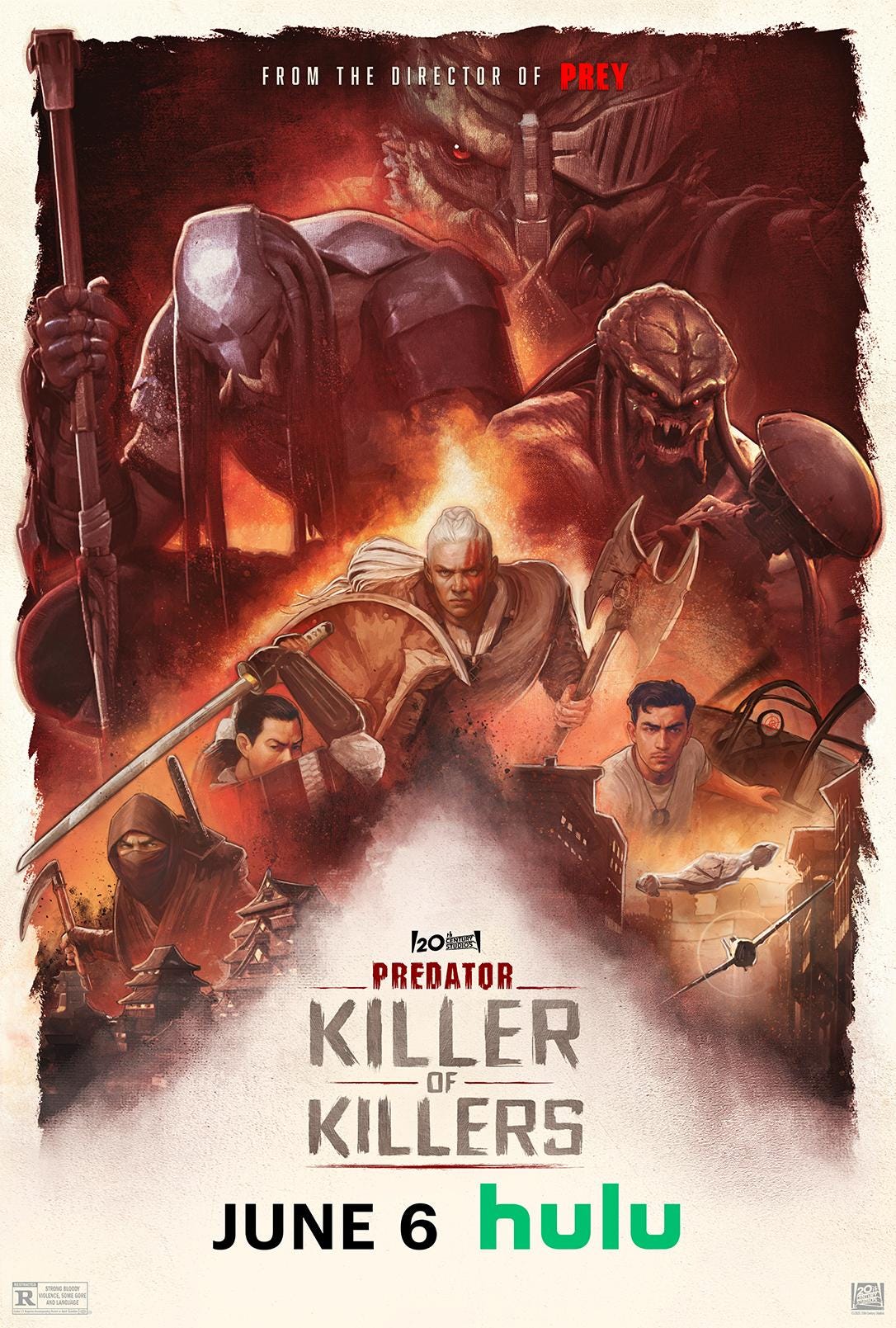
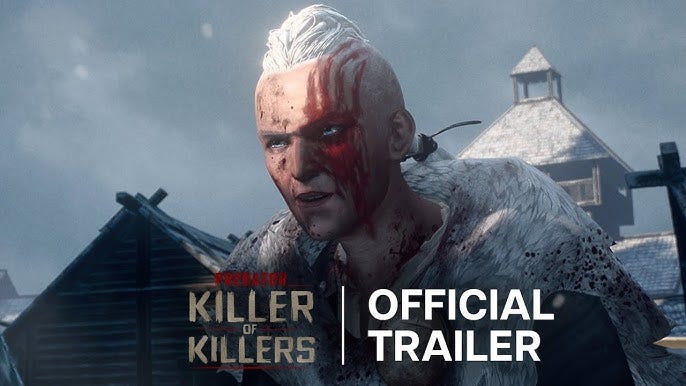

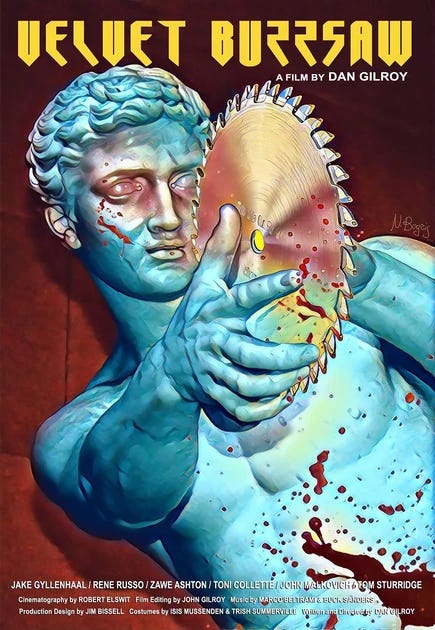
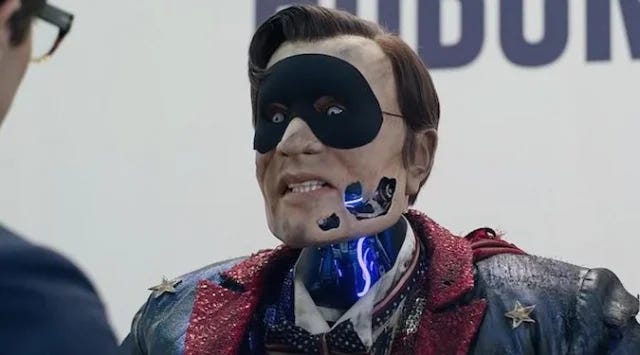


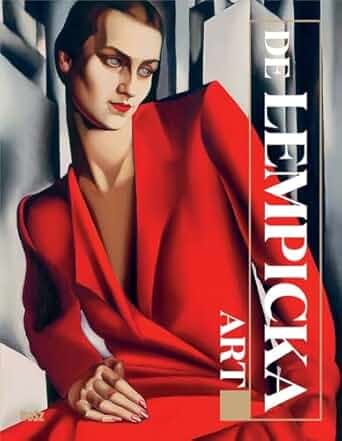
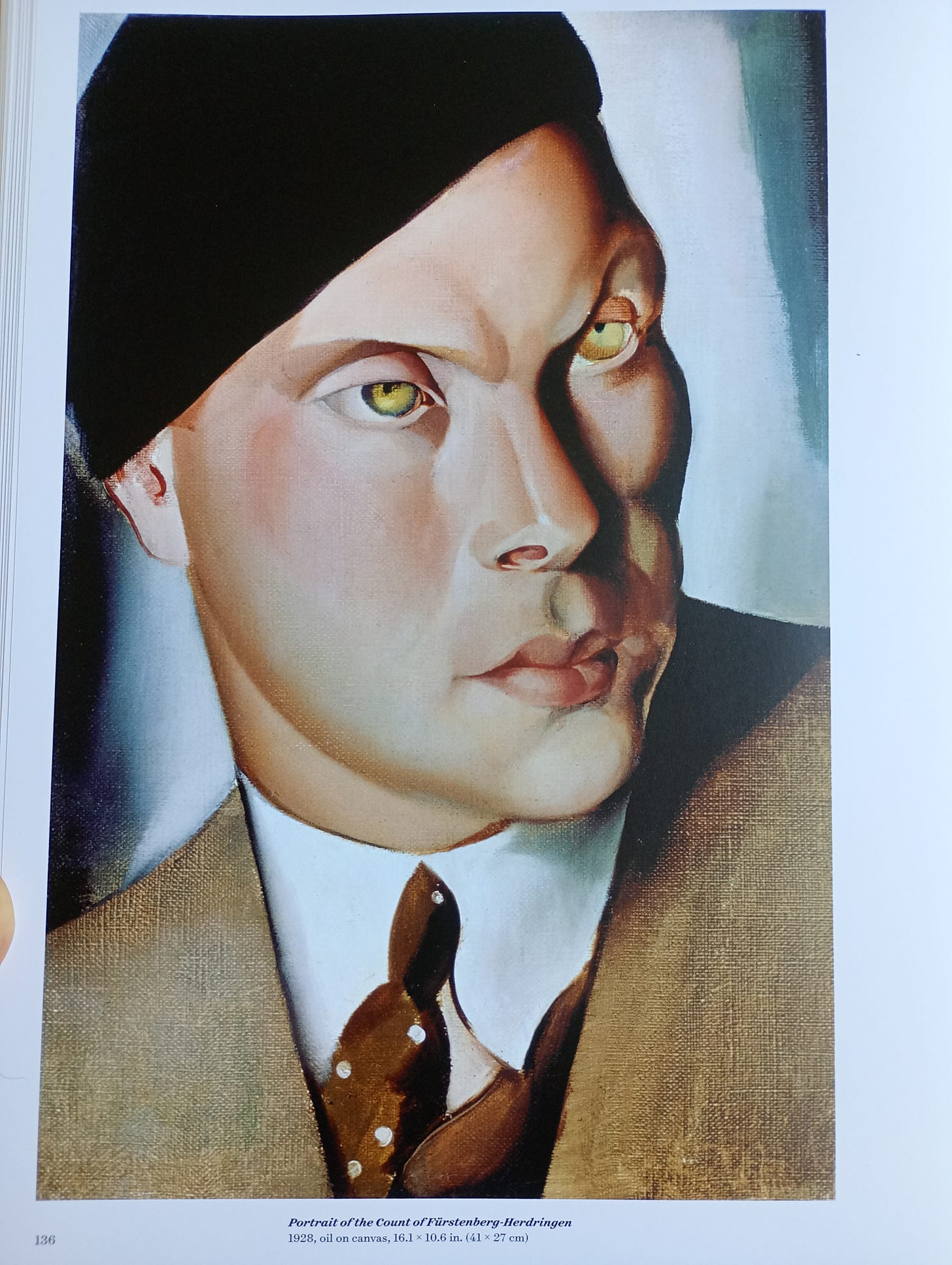
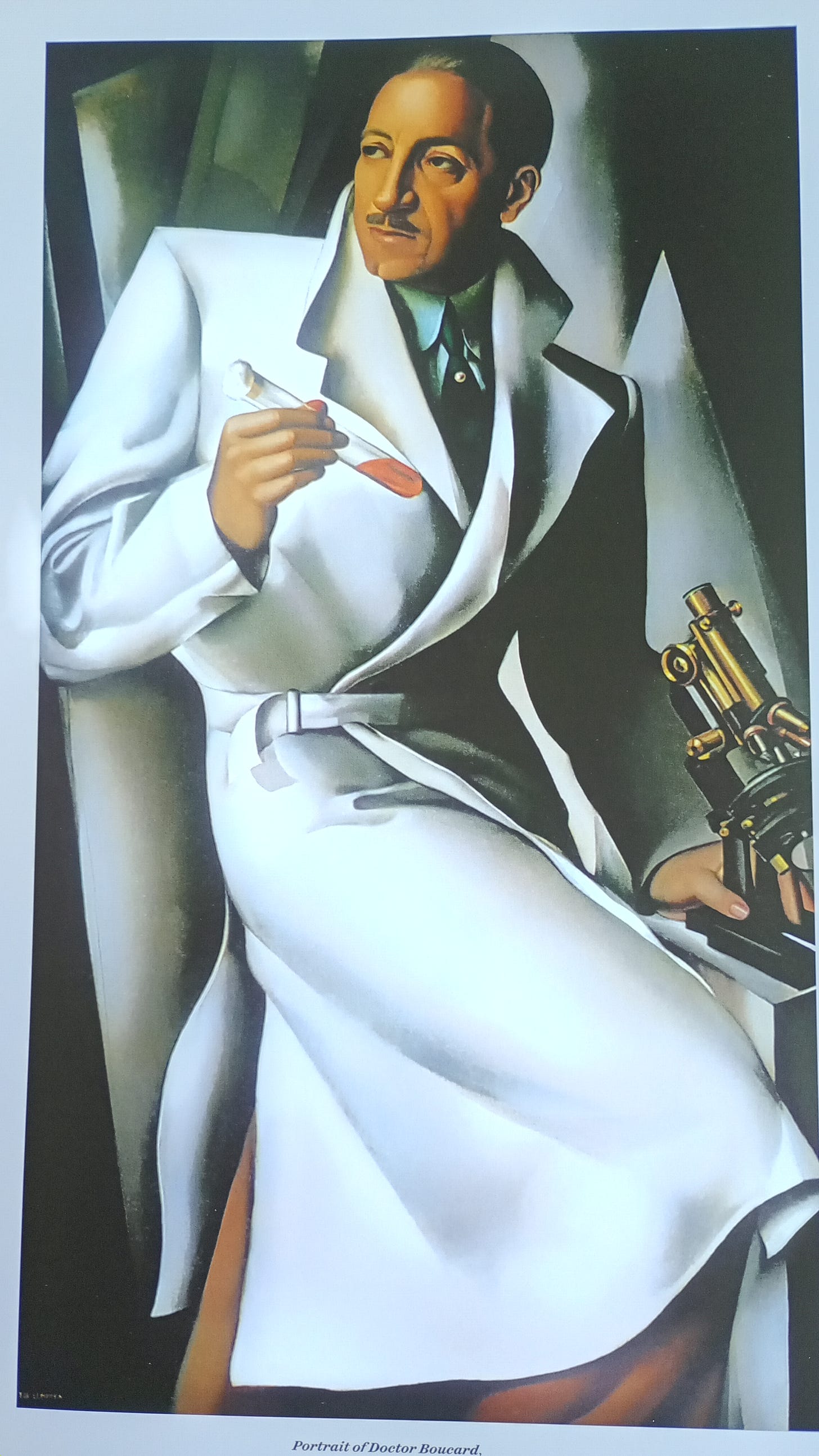
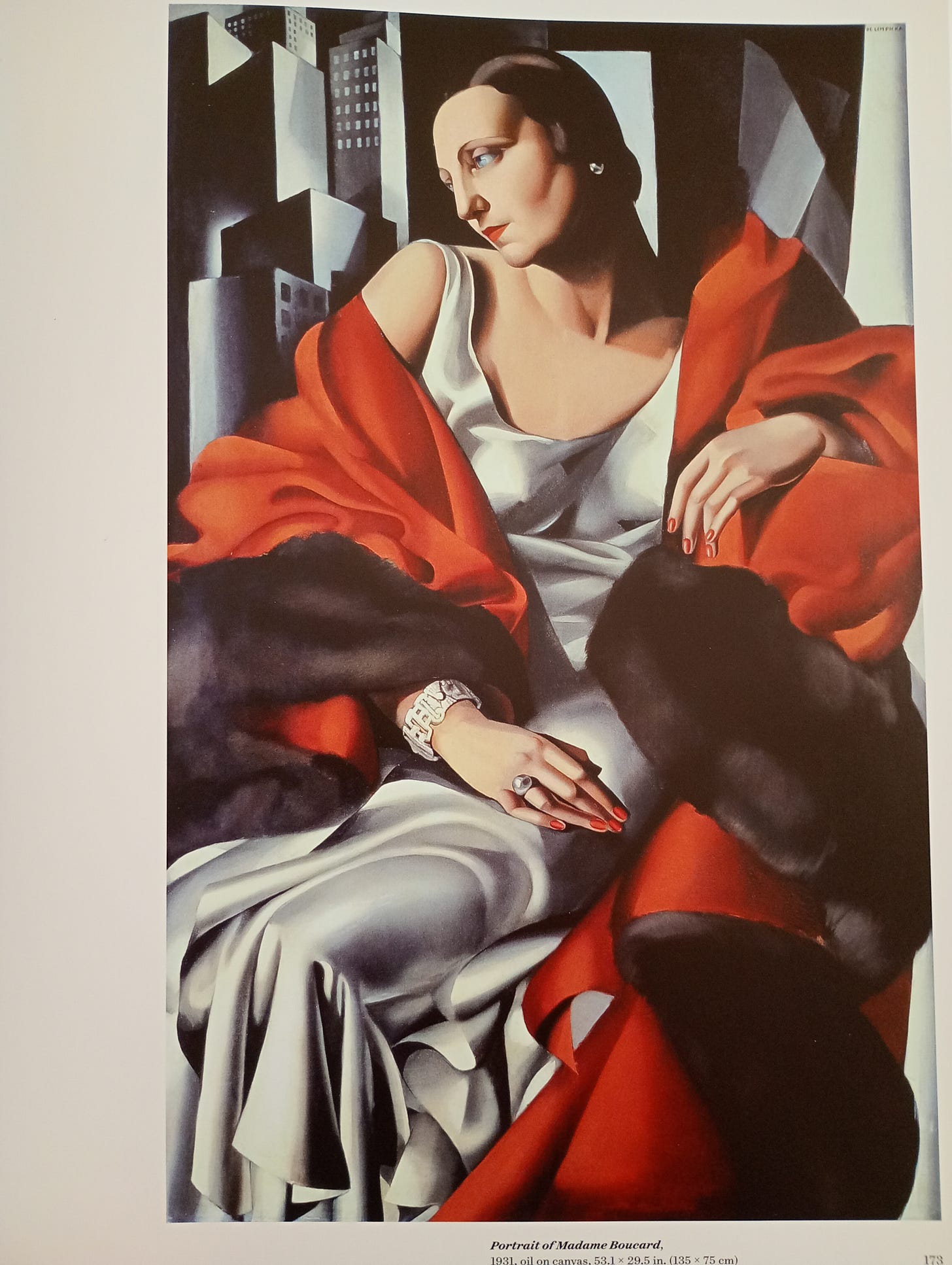
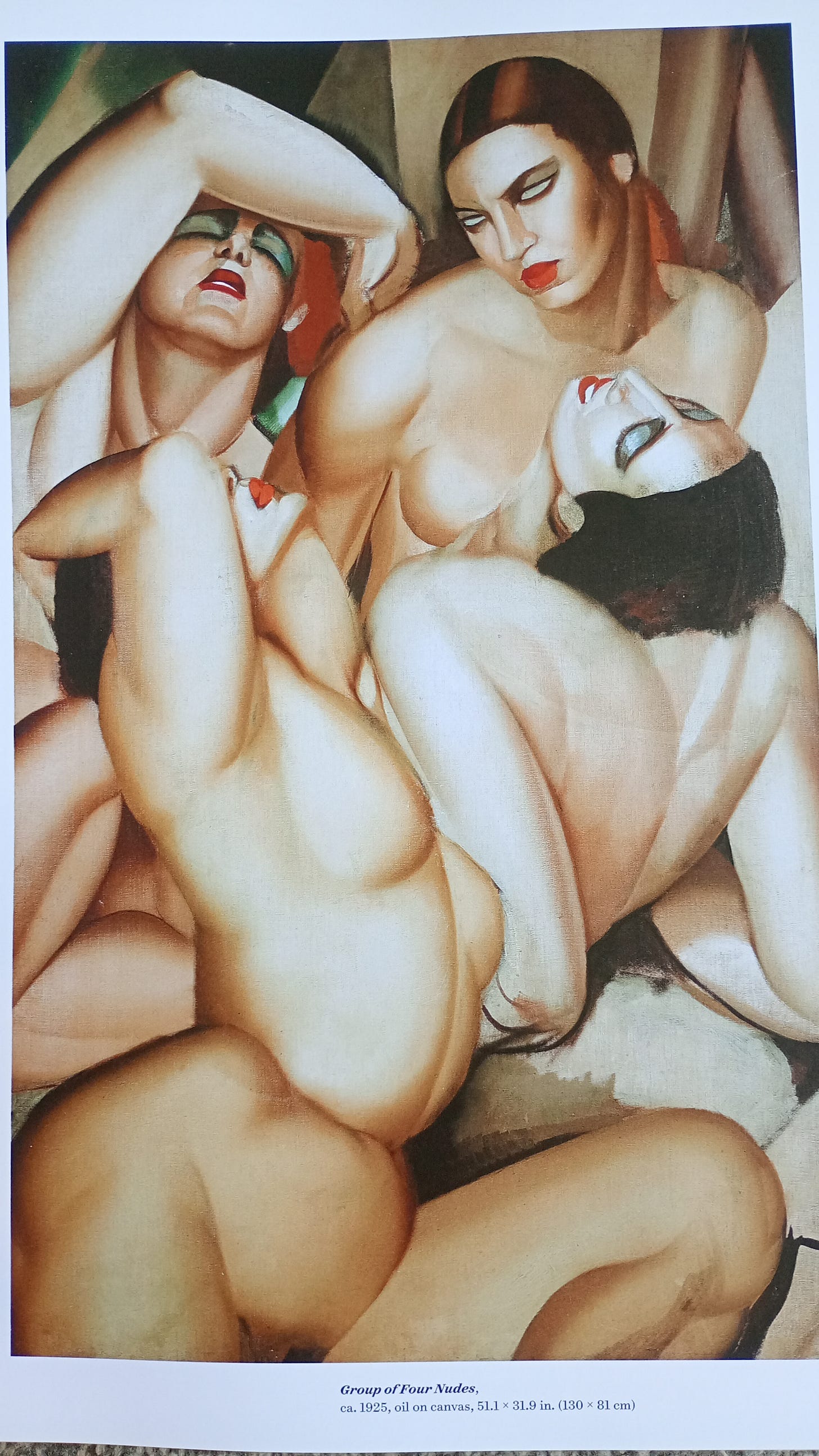
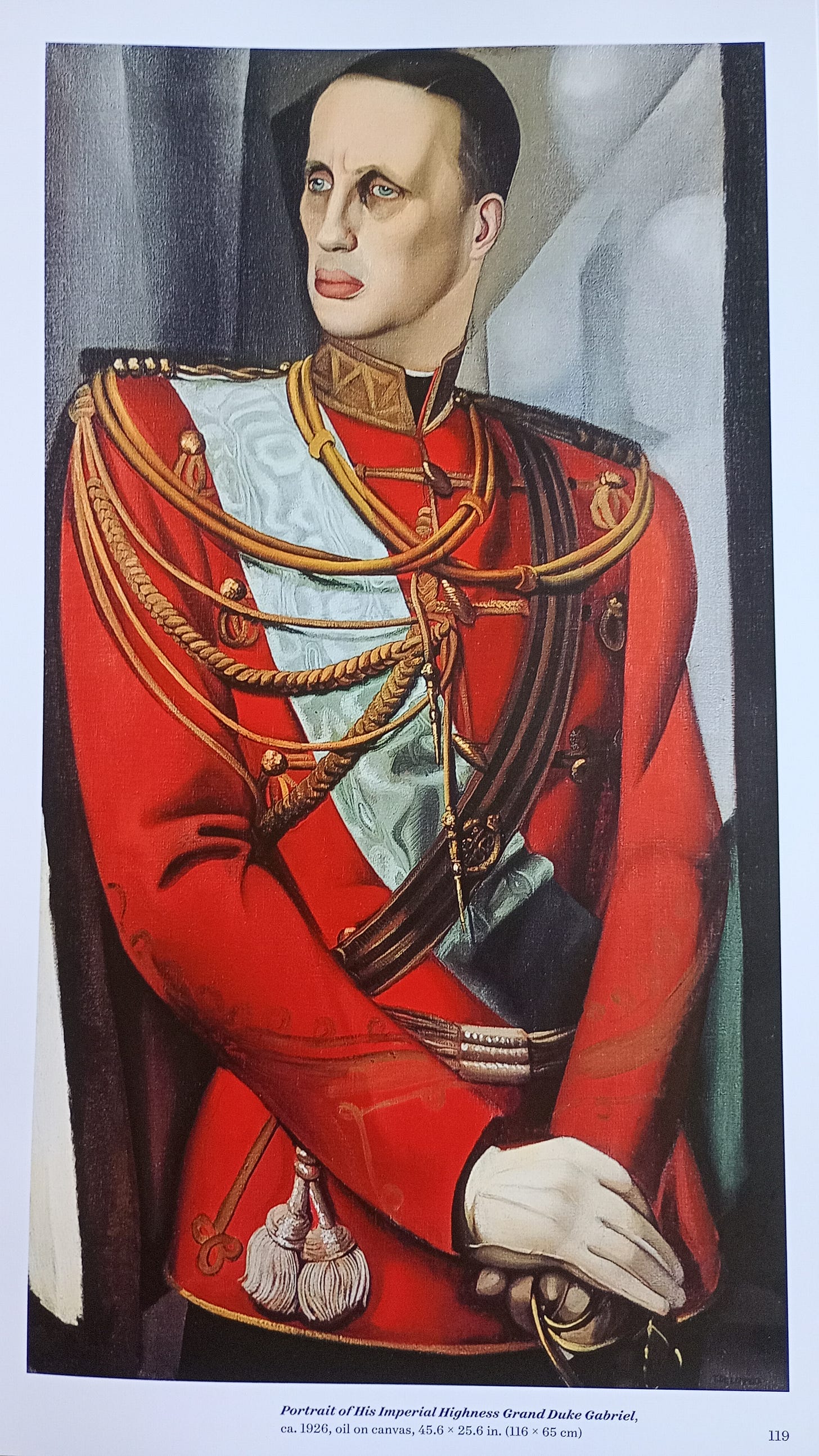
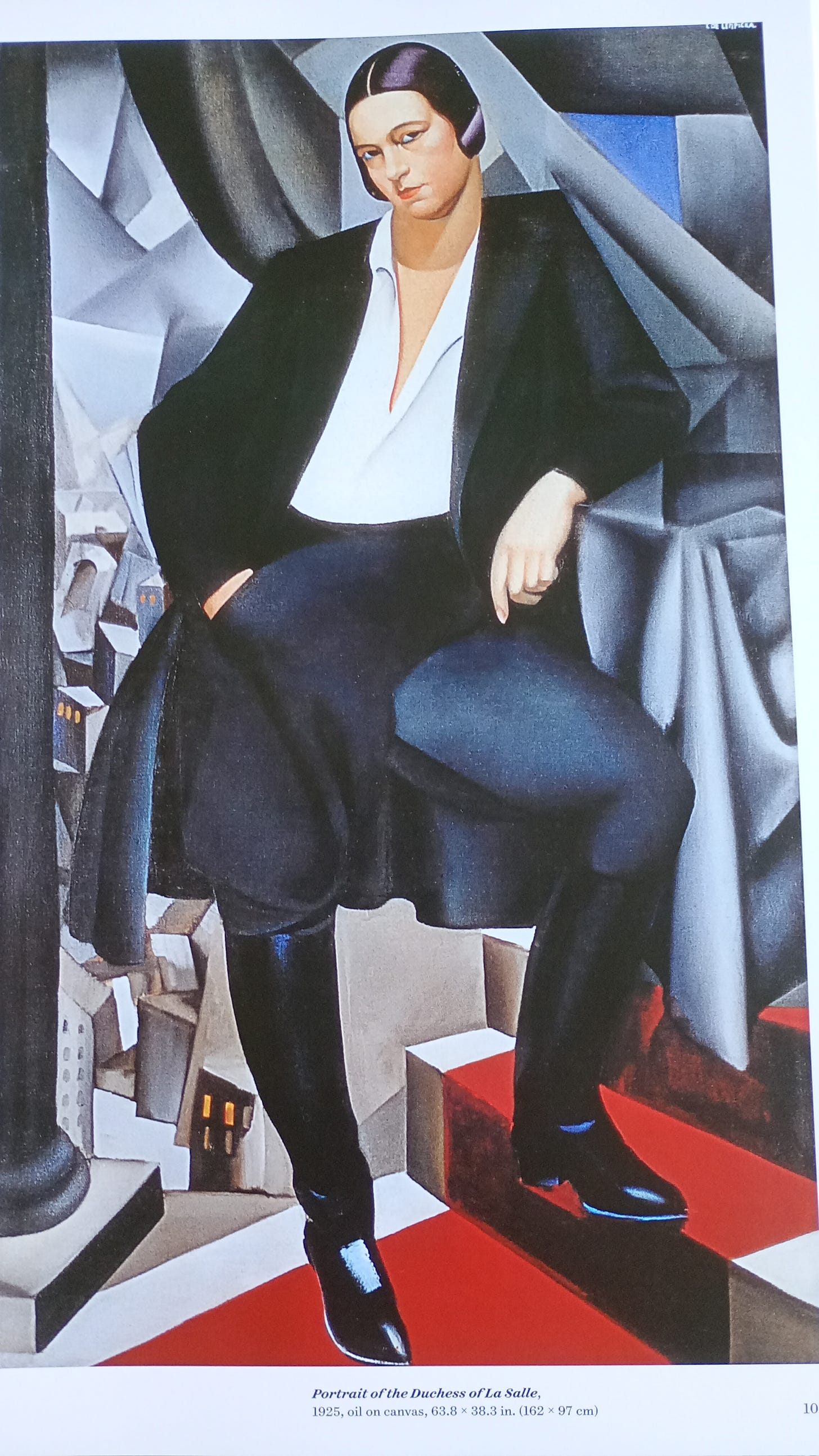
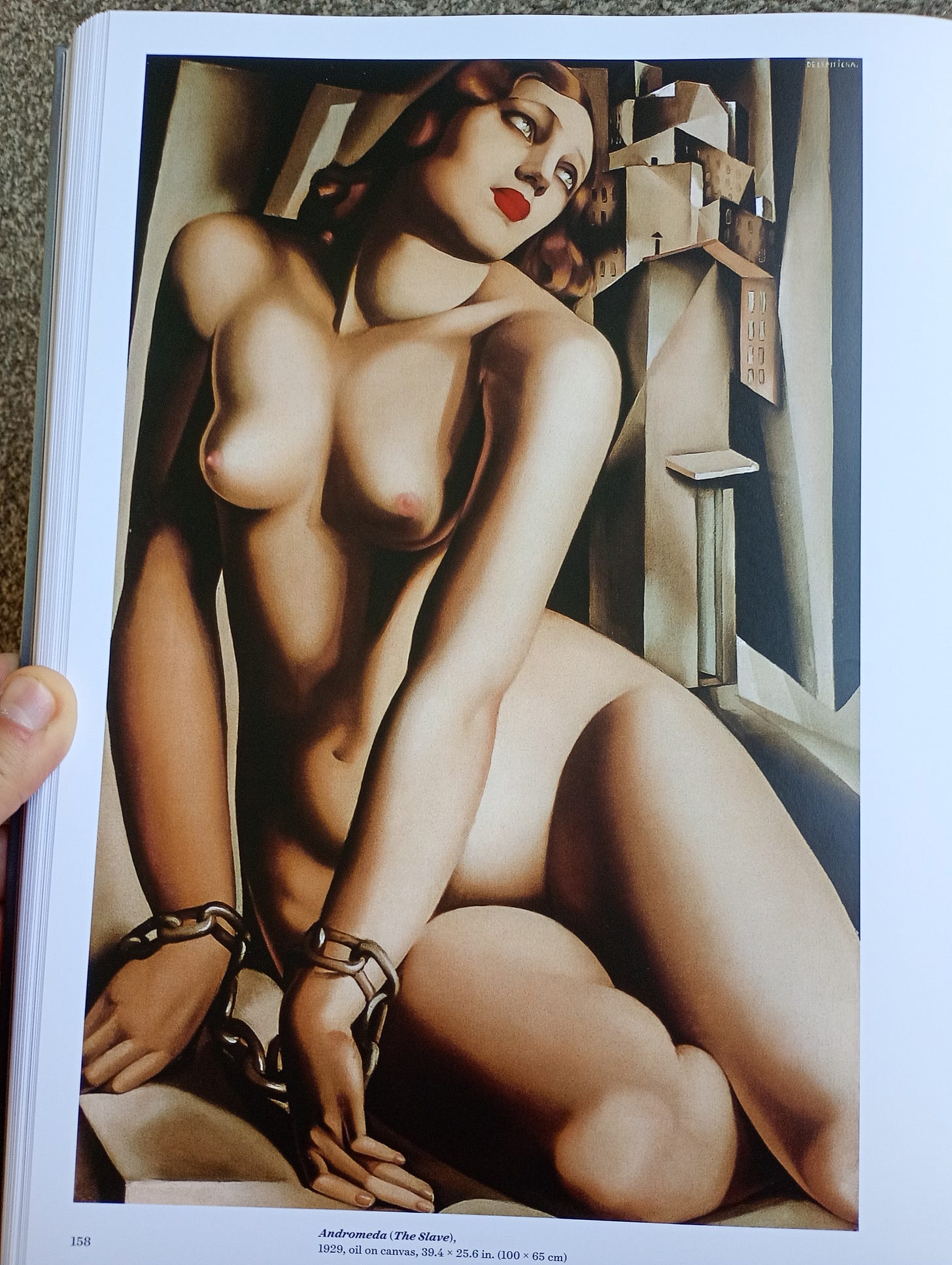
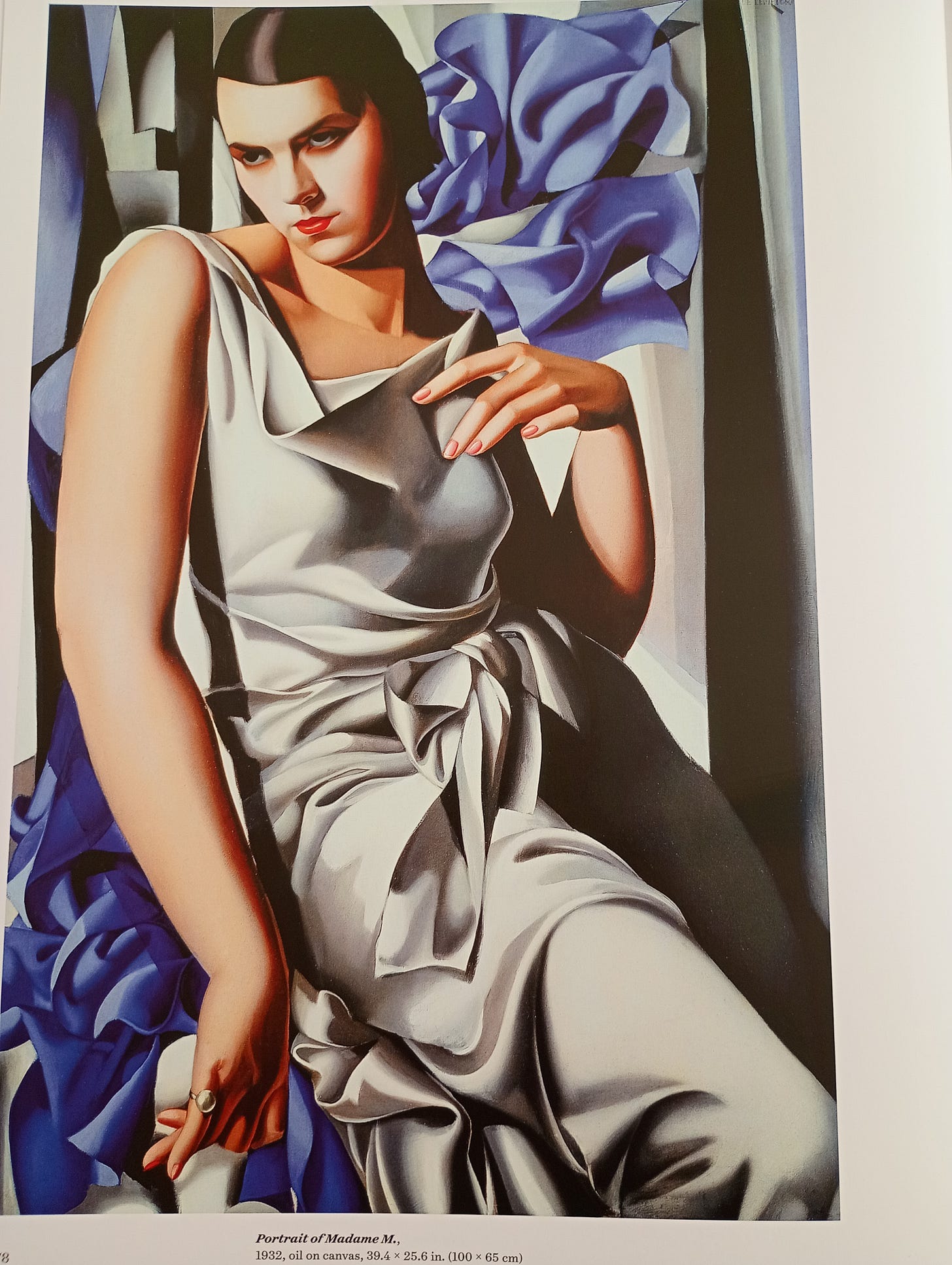

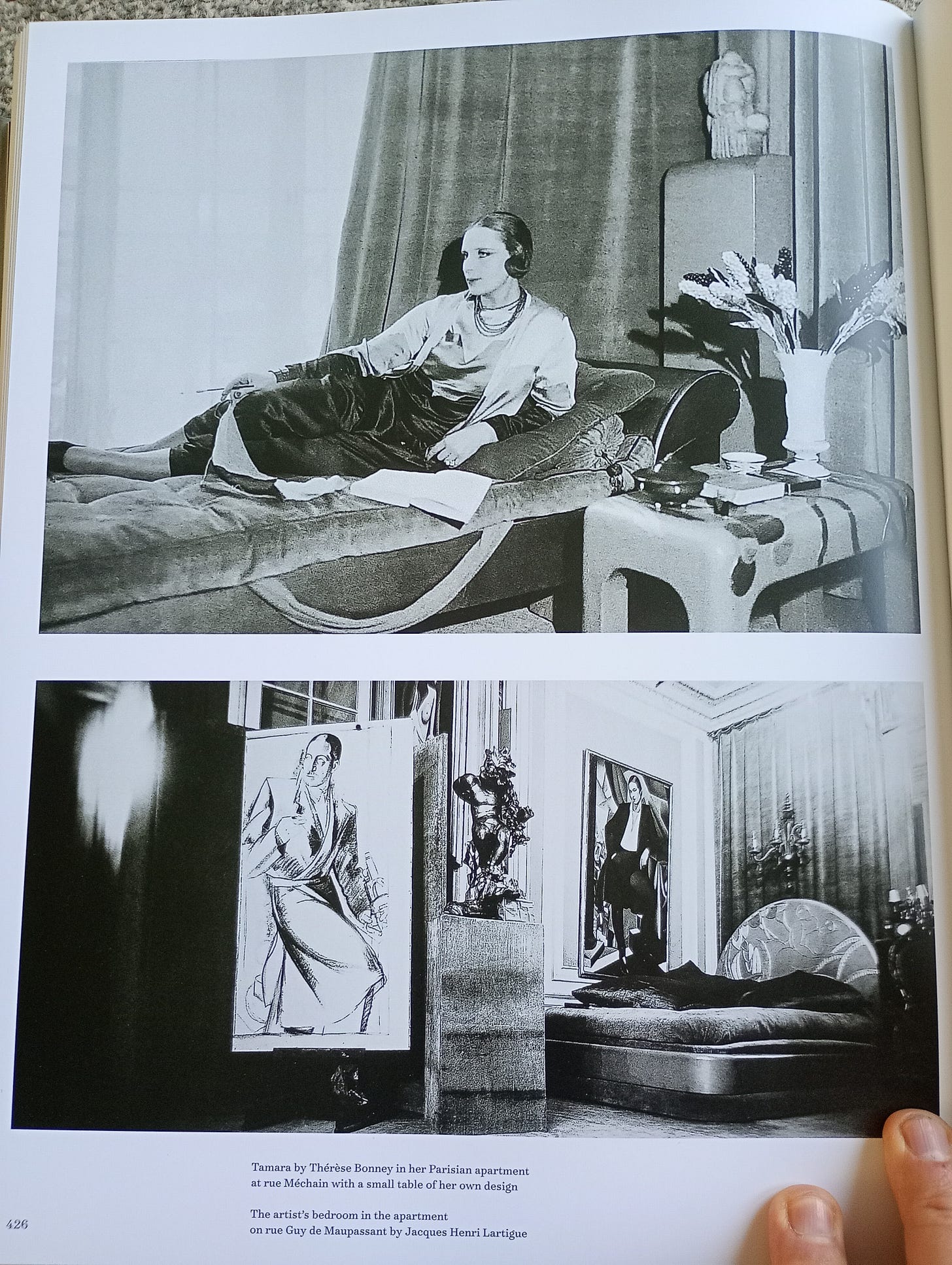
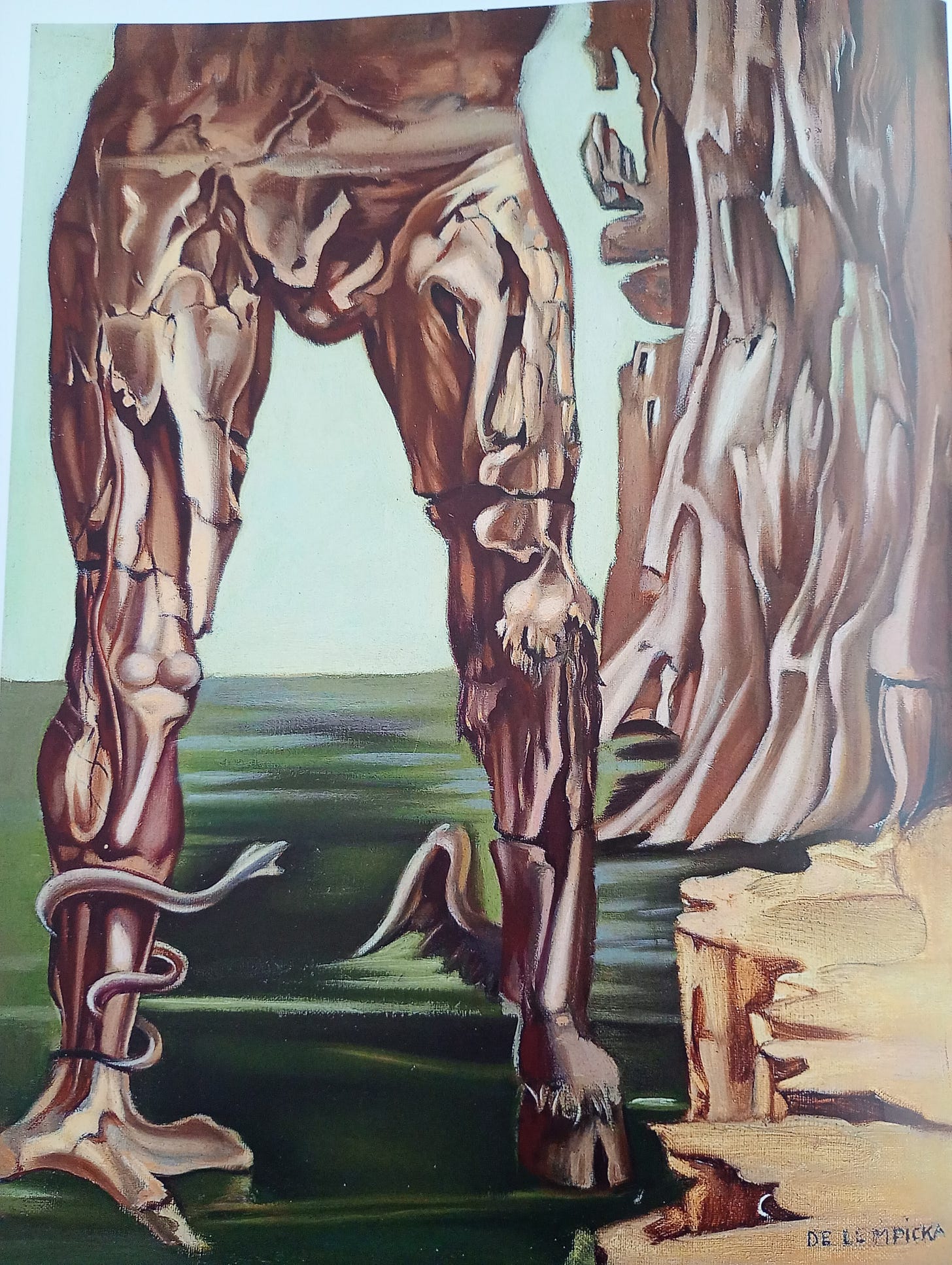
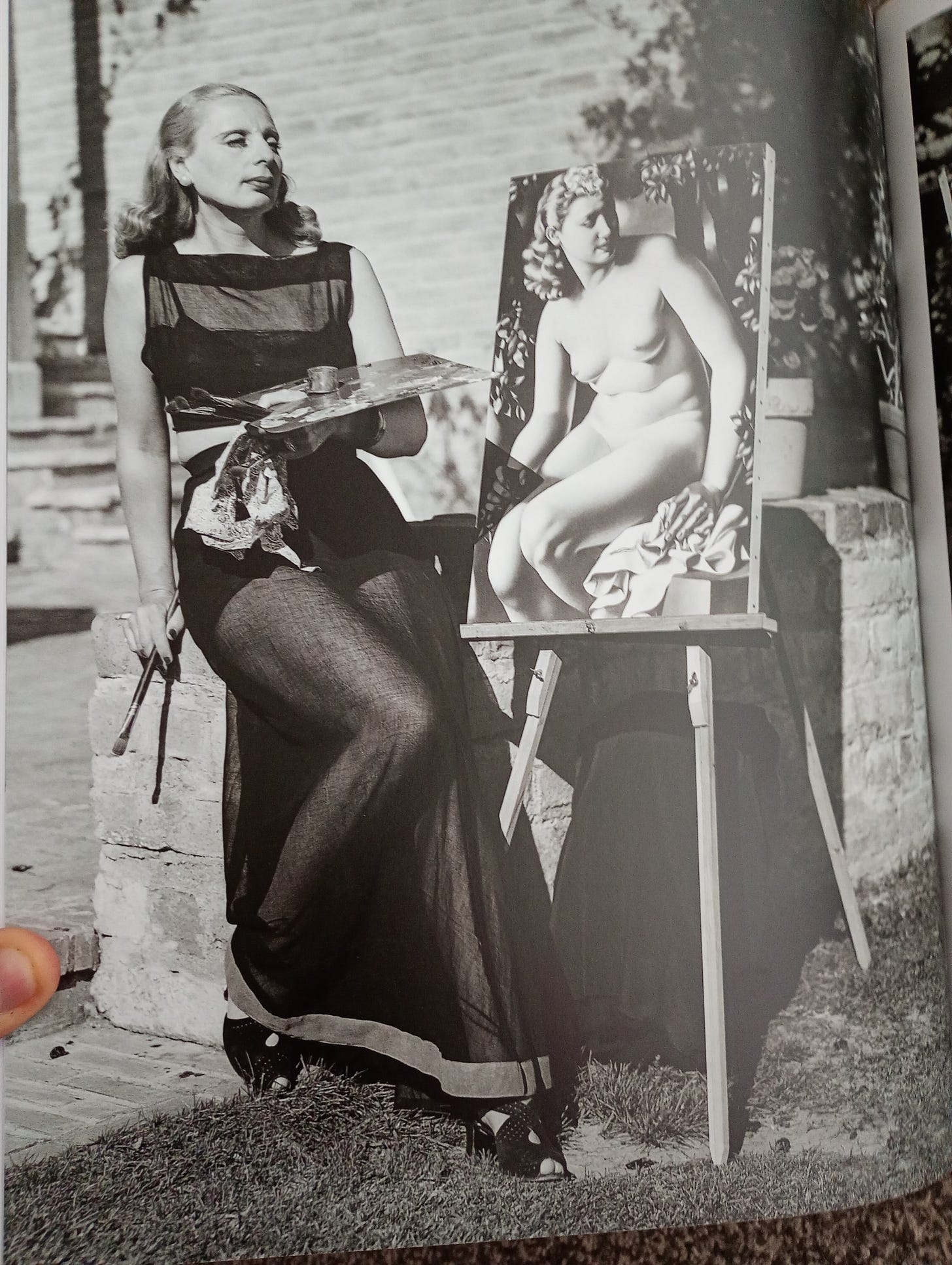
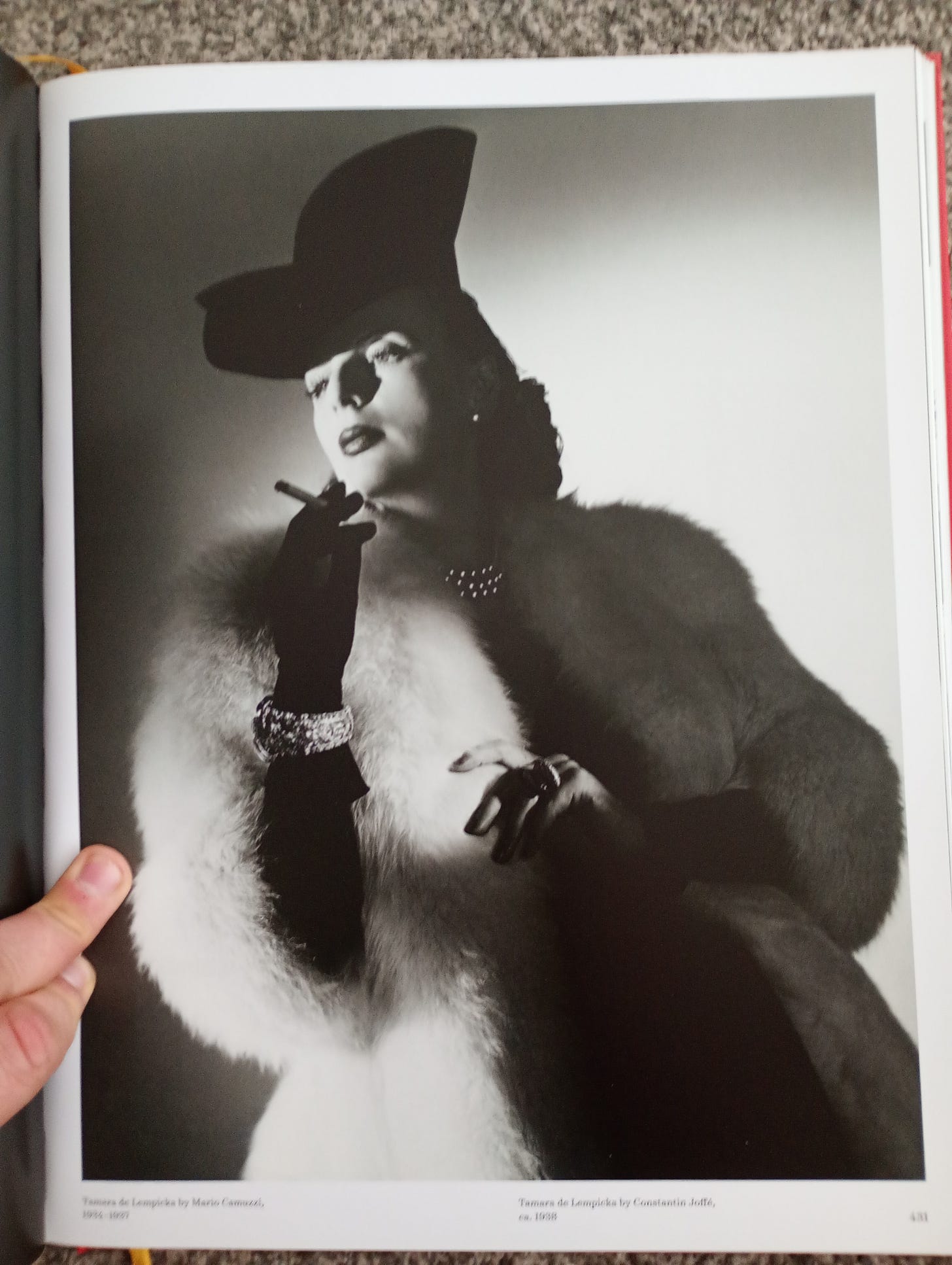

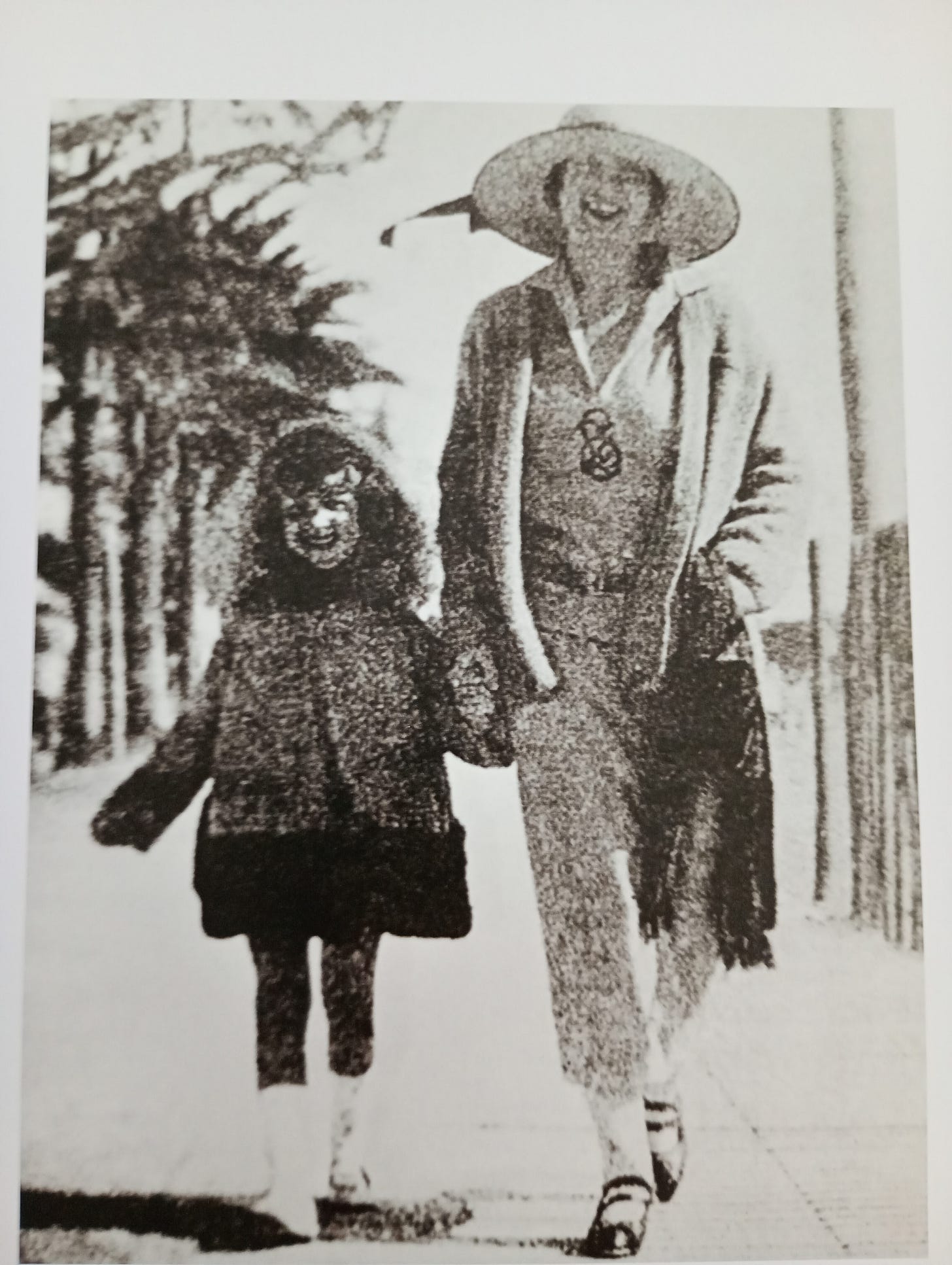

Polish people claim Tamara Łempicka as ours as she spent most of her early life in Warsaw, and because we like to claim jewish citizens as poles when it's convinient. I think her coming from "extremely fine and limpid European style mid-century wealth" is much more accurate than any nationality-adjacent description could provide.
Thank you for tracking down some Vansittart so quickly!